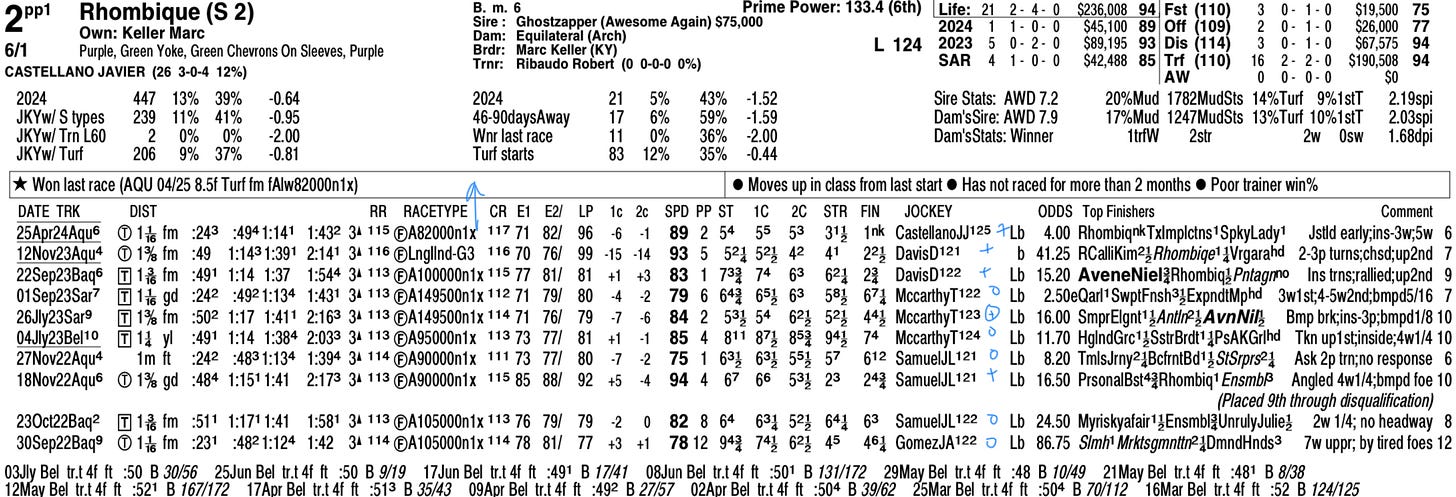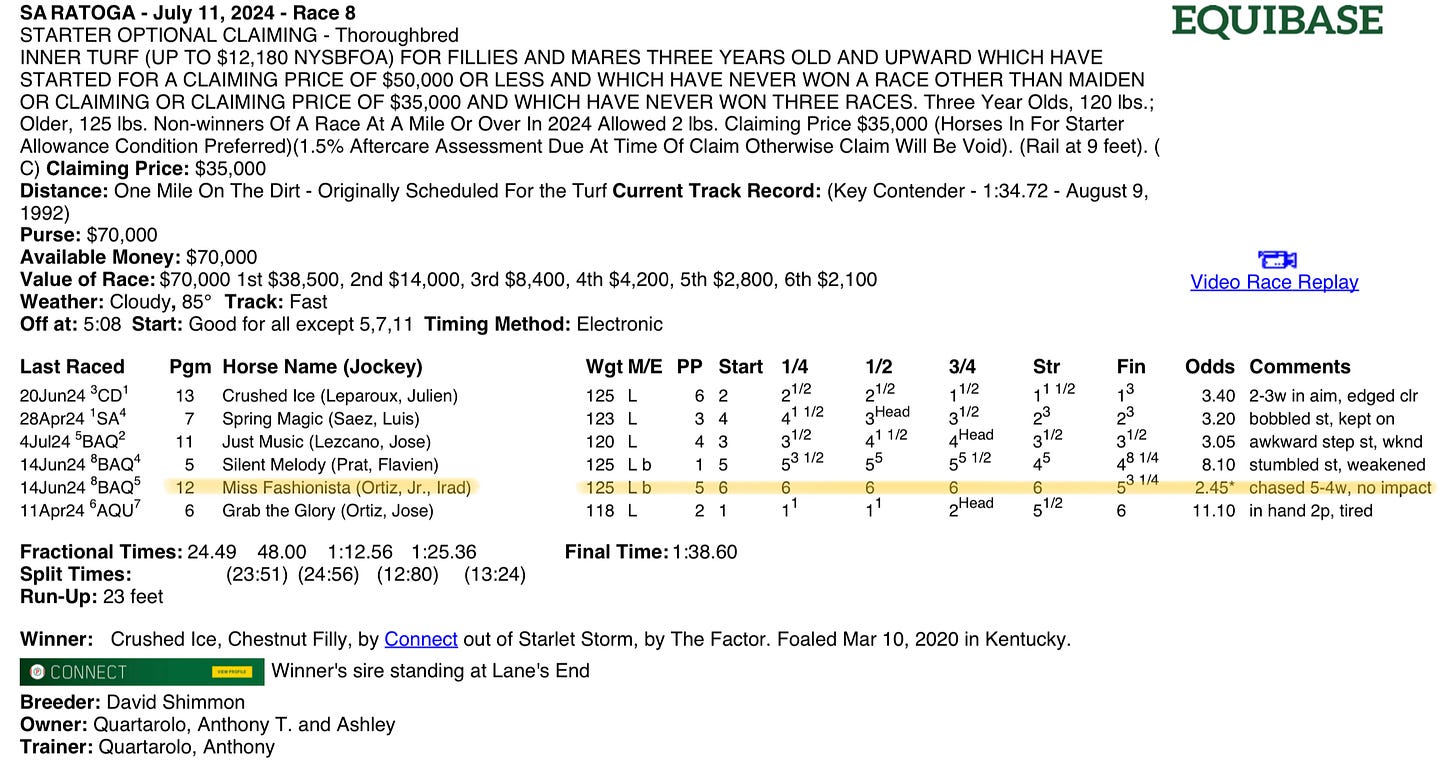The Best Way to Evaluate Horse Racing Form
Learn how to quickly evaluate horse racing form using a simple system. Improve your handicapping by spotting in-form contenders, eliminating false favorites, and improve your betting results.
This simple form cycle system will improve your handicapping by helping you identify contenders, eliminate weak runners, and find high-value betting opportunities. This will allow you to quickly analyze which horses are in form and those that are not in form.
So, what are these symbols I use on the right on each running line in my form and what do they do?
They are how to determine form and horse racing form cycles.
This is an easy and fast way to look through a horse's past performances and give them a grade. After grading each race, you can easily tell where a horse is most competitive.
More importantly, you won’t have to question if a horse is in form or not. Their form cycle will be right there to view quickly.
You’ll see horses that should be viewed as in form and contenders. You’ll also see the potential pattern of a horse out of form. Be ready to eliminate them. The best is when we find that short-priced horse that has no form. Utilizing this simple system will help you find who is and isn’t in form.
So, what is each symbol and what do they represent?
What is a Plus Race in Horse Racing Form Analysis?
A “plus” race is a good race.
A horse that runs in the money gets a plus rating. This is a race where the horse was a threat to win the race and could handle the pace that was run. The horse ran with promise. These are the races we are evaluating the most.
What is a Zero Race When Evaluating Horse Racing Form?
A “zero” race is a bad effort.
The horse did not run well early or late in the race. They lacked the speed to be in the front half of the pack early and didn’t have the punch late to close into the fractions.
What is a Plus Within a Zero Race Rating in Horse Racing Form?
The “plus within a zero race” is more of a subjective mark, but should be used when the horse ran a good race within a bad race.
That can be a horse that ran on or near the pace early before fading. It could be a horse holding or gaining position while holding or cutting into the beaten lengths from 1st to 2nd call.
A horse that sets the fractions at the 1st and 2nd call before fading will always earn a plus within a zero. They did all the work early before the off-the-pace runners caught them.
Usually, the races that earn this make are a fading result. The horse can maintain the pace early but comes up empty late.
What Can You Gain With The Form Cycle Symbols?
This is the most exciting part of the symbols. We can utilize the plus and zero races to draw the most conclusions from a handicapping perspective.
A plus race tells you where the horse excels. You can see:
The horse’s preferred surface
What is their best distance
A pace they can overcome and run competitively against
On the flip side, we gain even more looking at the zero races. We need to question everything about these races.
Is this the horse’s preferred surface?
Is this a distance they cannot win running?
Is the pace too much for them to handle?
Is the class level too high?
All of these questions can easily explain a poor effort. Many times you’ll see that horses are being misplaced and not entered in spots they can win. Use this to your advantage as a bettor.
Races that fall into the plus within a zero category are horses that can be dangerous. These are the “dirty form” horses you hear handicappers talk about. They are running a good half of a race. Those are efforts horses build on. The same questions you ask when a horse earns a zero can be applied here. Many times a class drop or easier pace scenario makes these runners a threat in their next start because they displayed ability against tougher in the plus within a zero race.
How to Utilize Form Cycle Analysis
Start with the oldest start in a horse’s past performances and start marking each race with the form symbols. This is a quick process for each horse’s prior races.
The symbols you just graded each race with give you a quick way to see how the horse is coming into today’s race. The last two races are the best clue to judge form for today’s race. This is where you need to start drilling pattern recognition into your handicapping.
Any horse with a plus race in one of their last two starts is in form. They are coming in with a good effort and should be respected for their current form.
Horses coming into a start with two or more consecutive plus races will always be dangerous. They get attention in the betting and are going to be a logical contender more times than not. Looking to beat these horses off of form isn’t possible.
Looking at this horse, we see they are coming in with three straight races of good performances. They are in form and should be respected for that. Each of the last three races would be good to evaluate the horse.
Here is another example of a horse that is in form. They are coming in with a plus race in one of their last two starts. Last time out, this horse ran a plus within a zero race. You see how they set the early fractions before being caught late. That is a race that makes a horse dangerous. A race with less early pressure could make this horse a threat to win.
This example is a perfect one for how to evaluate a zero race. First off, the horse is in form. They have a plus race in one of their last two starts. The zero grade was given because the horse lost positioning from 1st to 2nd call before being blown out. This is where reading from oldest to newest line is important. Let’s break down each start starting from the bottom:
Line 1 - Maiden Special Weight win
Line 2 - Stakes win
Line 3 - Optional Claiming race with a positional and beaten lengths move 1st to 2nd call. Finished in the money.
Line 4 - Allowance win
Line 5 - Grade 3 Stakes race and showed nothing
In this case, the “zero” race has a logical excuse. The race was a shot taken against a level for the first time. They are a stakes winner and were looking to find their class level. We see there is promise, but graded-stakes races look to be just out of touch for them right now.
Here is a horse that is a proven winner and took a logical shot in a graded stake race. Today they are dropping in class. The class of graded stakes horses will not be in their way for this start.
The WORST Form Cycle to Have
Anytime we see a horse coming in with two or more straight zero races, look to toss them and do it quickly.
These horses are struggling and a race where they just contend would be a positive. As far as betting, they win at a low rate. Handicapping races is about giving excuses when necessary, but there is one line that you should live by when evaluating form…
Horses coming in with no form do not deserve excuses.
You have to hold these formless horses to a high standard. If you start giving them excuses, you’ll be burning through your bankroll. A lot of times you find these horses dropping in class and many handicappers would think they will improve with the class relief. That is true with horses in form, not horses scrambling to get back on track.
The best is when you find a horse at 3/1 or under that is coming into a race with multiple zero races. These horses should become automatic fades because we are eliminating the track takeout with one horse and increasing the value on other runners. Take advantage of the public’s support. Stand strong that you know a horse’s form is suspect, especially when getting a lot of attention in the betting.
This exact scenario happened on opening day at Saratoga on July 11th. This was a race off the turf that became playable with a false favorite. Look at the form of 12 Miss Fashionista.
She is coming in with three straight zero races. She has no form whatsoever.
Going to her last “plus” race, that was when she broke maiden at the $30,000 claiming level. Look at the paceline of that win. She faced a ridiculously slow pace of race. Looking at the adjusted 1st and 2nd calls, we see a -13 and -10.
This is a suspect horse who needs slow fractions to win and should be immediately tossed coming in with no form. She ended up becoming the 2/1 favorite in this race and could have been eliminated in minutes by just looking at her form.
How to Implement This In Your Handicapping
The first thing to do when opening up your form should be to evaluate the form on each runner.
In just 10 minutes you can go through the entire card and grade each race for each runner. This can prime every field for you to handicap when it comes to diving into who your contenders are going to be.
Form Analysis Takeaways
Horses with 2+ plus races → Always contender
Horses with a plus within a zero race → hidden form, dangerous at a price
Horses with 2+ zero races → no form, look to eliminate quickly
Remember, question yourself why a horse earned a grade when handicapping the race. Did they earn a zero because of the class level or was it because they cannot run to those fractions? Understand why a horse runs a plus race. The same questions apply. Was it because of a class drop or possibly the fractions set them up to run well?
This style of form analysis is a key pillar to put into your handicapping toolbox. From just this basic practice, you can gather a lot more information on runners and trigger your mind to question why a horse is or isn’t a player in the race today.
Keep your eye out for those multiple zeros on horses getting support in the betting. Those are some of the best opportunities to find to bet in this game.












Excellent Ryan, thank you for this. So form is analyzed. Next step is finding the early speed, correct?